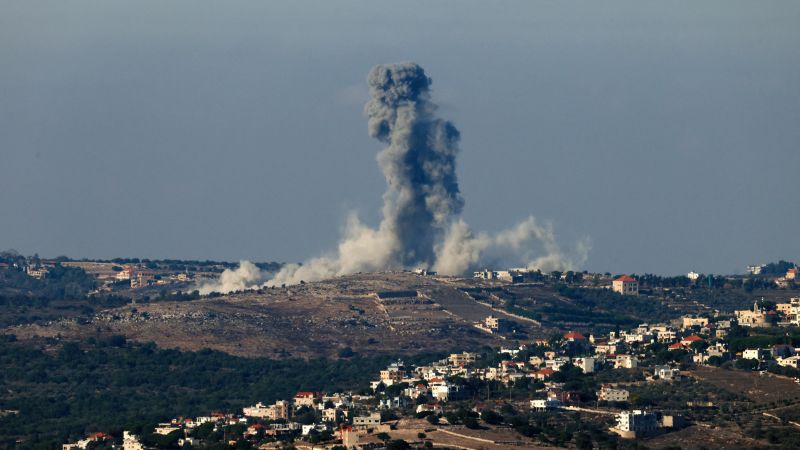Beirut
CNN
—
Killing Hezbollah leader Hassan Nasrallah was a step toward changing “the balance of power in the region for years to come,” Israeli Prime Minister Benjamin Netanyahu declared Saturday.
Israel’s leader sees an opportunity opening up for a fundamental reconfiguration of power in Middle East and he may assume that Hezbollah are mortally wounded. Total victory, however, is elusive, and those who get what they wish for often live to regret it.
Since Sept 17, Israel has dealt the Iran-backed militant group one body blow after another in Lebanon — first the pager and walkie talkie blasts, then a massive air strike on southern Beirut which killed senior commander Ibrahim Aqil (along with at least two dozen civilians), followed three days later by the start of a brutal bombing campaign. By Friday evening – when Nasrallah was killed in a bombing that flattened multiple buildings – Hizballah’s senior leadership had been almost totally eliminated.
Yet recent history offers only bitter lessons for Israeli leaders — and others — who entertain grand ambitions for tectonic changes in Lebanon, and in the Middle East in general.
In June 1982, Israel invaded Lebanon with the goal of crushing the Palestinian Liberation Organisation. Beyond that, it hoped to establish a malleable Christian-dominated government in Beirut and to drive Syrian forces out of the country.
It failed at all three. Yes, Palestinian armed groups in Lebanon were compelled to leave the country under an American-brokered deal that sent them into exile in Tunisia, Yemen and elsewhere. But the goal of quashing Palestinian national aspirations along with the PLO failed. Five years later, the First Palestinian Intifada, or uprising,broke out in Gaza and spread to the West Bank. Today the Palestinians are as adamant and restive as they’ve ever been in their rejection of Israeli occupation.
Israel’s main ally in Lebanon at the time of the invasion was Bashir Al-Gemayel, a Maronite Christian militia leader who was elected by parliament, but before he took office was assassinated in a massive blast in east Beirut. His brother, Amin, replaced him, and under his leadership and with active American involvement and encouragement in May 1983 Lebanon and Israel signed an agreement for the establishment of normal bilateral relations. In the face of intense opposition, the government fell the following February and soon the agreement was abrogated.
The US, which had deployed troops to Beirut after the September 1982 Sabra-Shatila massacres, pulled out after its embassy was twice bombed, along with the US marines and French army barracks in October 1983.
The Lebanese civil war re-erupted and raged on more than six years.
Syrian forces, which had entered Lebanon in 1976 as a “deterrence force” under an Arab League mandate, didn’t leave until 2005 after the assassination of former Prime Minister Rafiq Al-Hariri.
Perhaps the most significant outcome of the 1982 Israeli invasion was the birth of Hezbollah, which went on to wage a relentless guerrilla war that compelled Israel to unilaterally withdraw from south Lebanon – significantly the first and only time an Arab military force successfully pushed Israel to retreat from Arab land. This new group, with Iran’s help, proved to be far more lethal and effective than the Palestinian militants Israel had successfully driven out.
Hezbollah went on to fight Israel to a standstill in the 2006 war, and in the following years grew only stronger, with significant Iranian help.

Today Hezbollah is crippled and in disarray, and clearly infiltrated by Israeli intelligence – but still, it would be premature to write its epitaph.
Beyond Lebanon and Israel, there is the example of the 2003 US-led invasion of Iraq, a lesson in the wages of unfettered hubris. As the Iraqi army crumbled and US troops raced to Baghdad, the George W. Bush administration entertained fantasies that the fall of Saddam Hussein would lead to the toppling of regimes in Tehran and Damascus, and ignite a flowering of liberal democracies across the region.
Instead the US occupation of Iraq descended into a blood bath of sectarian violence, in which the US paid dearly in blood and treasure, the people of Iraq even more. The killing of Saddam Hussain allowed Iran to spread its influence to the very heart of the political establishment in Baghdad. Al-Qaeda, shattered by the US-led invasion of Afghanistan, was reborn in Iraq’s Sunni triangle, and eventually morphed into the Islamic State in Syria and Iraq.
As I write this, I see smoke rising from across Beirut’s battered southern suburbs and recall the words of then-US Secretary of State Condoleezza Rice who, during the 2006 Israel-Hizballah war, said all the bloodshed and destruction we were witnessing then were “the birth pangs of the new Middle East.”
Beware of those who promise a new dawn, the birth of a new Middle East, a new balance of power in the region. Lebanon is a microcosm of all that can go wrong. It’s the land of unintended consequences.


